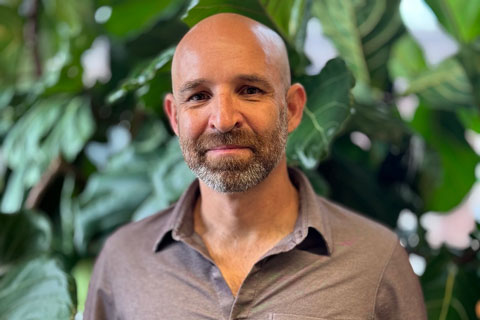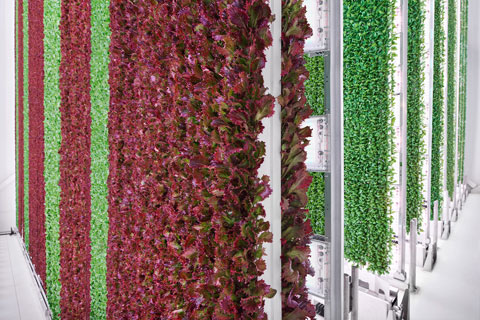2/1/2024
Bringing Out the Best in a Crop
Jennifer Polanz

Recently, I had the opportunity to virtually meet and chat with Dr. Sasha Preuss, who at the time had about three months (now about six months) under his belt as the VP of Plant Science at Plenty, a vertical farm grower with operations in Compton, California (leafy greens), and a forthcoming farm campus in Richmond, Virginia (strawberries, grown in partnership with Driscoll’s).
Picturd: Sasha Preuss, VP of Plant Science at Plenty.
He’s located at the R&D facility in Laramie, Wyoming, where he moved from Dusseldorf, Germany, after a two-year stint at the Bayer Crop Science laboratories there. Prior to that, he was at Bayer’s (and before that Monsanto’s) facility in St. Louis, Missouri, working on crop improvement, molecular genetics and genomic sequencing, robotics automation, and software development. This interview has been edited for length.
Inside Grower (IG): How do you apply your experience in technology to what you’re going to do at Plenty?
Sasha Preuss (SP): What Plenty is trying to do—if you take the long arc of agriculture—is fundamentally change how we’re growing and delivering food. What Plenty is trying to do is take that whole paradigm and literally turn it on its head and start growing things vertically.
What we do here in plant science is optimizing crops generally, and often for the first time. For instance, how can we grow a crop in an entirely new environment and orientation, and what are the conditions by which we would grow the crop to maximize output? There’s a lot of potential; there’s also a lot of research that needs to happen to figure out how to do that.
IG: Tell me how you identify new indoor crops and varieties? What are some of those requirements you’re looking for?
SP: It’s twofold, right? First of all, what’s the market opportunity? And then second of all, what’s the potential for change? If you look at the market opportunity, of course there’s a lot of companies that have gone into leafy greens, us included. There are also fantastic opportunities in crops like strawberries.
Strawberries—I never realized that I was just part of the masses when I always saw them at the front of the grocery store and buy them and a bunch of other things. Strawberries are a great product and a great market, but then you look at the other end and you say, okay, is it tractable from a scientific perspective?
(Editor’s Note: Plenty let us know they’ve grown 50-plus different crops in their vertical systems and more than 1,400-plus cultivars.)
SP continued: So then from the scientific perspective, we screen through crops and say what is the tractability of that crop in growing in our environments—the indoor vertical environment, high density, being able to make use of the higher light intensity. It’s really that twofold play of market opportunity and tractability of the crop to being grown in this environment and being productive.
IG: Can you talk about some of the challenges you face when selecting new varieties? What makes it not viable?
 SP: I think the first challenge, and the obvious challenge, is for almost everything on Earth it’s never been grown in this kind of setting. The first challenge is saying—and I know your question is about not being viable, but I’ll take it a step further—even if it’s viable, is it optimizable? Does it respond to improvements in lighting, increases in lighting? Does it respond to experimenting with different light spectrums, with different temperatures? Because we have a lot of levers we can pull. So does it grow to a degree that is economically viable? That’s the primary thing. I’ve been at the company for several months, so a lot of the experimentation happened before my time.
SP: I think the first challenge, and the obvious challenge, is for almost everything on Earth it’s never been grown in this kind of setting. The first challenge is saying—and I know your question is about not being viable, but I’ll take it a step further—even if it’s viable, is it optimizable? Does it respond to improvements in lighting, increases in lighting? Does it respond to experimenting with different light spectrums, with different temperatures? Because we have a lot of levers we can pull. So does it grow to a degree that is economically viable? That’s the primary thing. I’ve been at the company for several months, so a lot of the experimentation happened before my time.
Pictured: Plenty grows vertically in an indoor environment versus the often-used stacked horizontal method. This is the Compton, California, operation.
IG: Let’s talk about partnerships and their impacts.
SP: We’re doing a lot of work with Driscoll’s right now on strawberries and I think for me the other really attractive thing about Plenty is the partnerships. If we’re going into strawberries, we’re going into strawberries with the industry leader. And as we’re commercializing our greens, particularly out in California right now, one of our major partners is Walmart.
Where we’re going with Driscoll’s and the Plenty strategy is really to be able to put a farm anywhere. And right now, today’s strawberries are flown around the world and there’s a lot of logistics in getting strawberries to the consumers. We can cut that logistic chain dramatically. There’s a great opportunity there … we’re partnering a lot with Driscoll’s and working with them on the science to realize that opportunity.
They have a lot of background in understanding their genetics and the strawberry germplasm. They’re able to partner with us to bring different genetics into our operations where we can then test it in a vertical environment and identify genetics that respond favorably to a vertical environment and respond favorably to what we can do with lighting and temperature and density.
IG: What are some of the things breeders can do that can help forward the industry—specifically CEA industry?
SP: If you don’t have genetic diversity, if you’ve got a germplasm that either you’re testing a very narrow range of that particular crop, you’re going to have more challenges adopting it for new environments, including vertical agriculture. So specifically with strawberries we’re really relying on Driscoll’s.
If you go beyond strawberries and you ask about crops in general, genetic diversity is a very strong tool for people, but then also using modern molecular genetics to be able to select for regions of the genome and being able to develop models based on genetics that allow you to predict for performance in an environment. So I think there’s a lot of potential in agriculture, and controlled environment agriculture is not an outlier, in being able to use genetics and use modern data science and computer science in order to make informed predictions and bring those into your environments.
But as an opportunity for the industry—and this is a point I want to make—Plenty, we’re at the beginning. Whether you’re talking about lighting, you’re talking about aspects of how we create our farms, the technologies that we leverage are becoming exponentially more powerful and less expensive. The genetics fits into that. So that’s what I see propelling Plenty into the future, is we’re really riding a fantastic wave of innovation that we’re able to leverage.